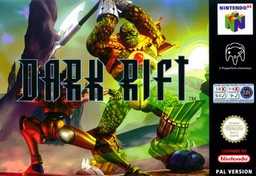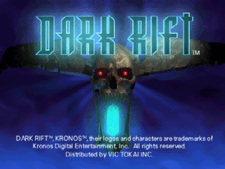Dark Rift
| Dark Rift | |
|---|---|
 European Nintendo 64 cover art | |
| Developer(s) | Kronos Digital Entertainment |
| Publisher(s) | Vic Tokai |
| Distributor(s) | Vic Tokai |
| Designer(s) | Stan Liu (Executive Producer) Albert Co (Art Director) Matt Arrington (Lead Programmer) Andy Koo (Animation Technical Director) Ted Wornock (Animation Director) John Paik (Production Design) |
| Platform(s) | Nintendo 64, Microsoft Windows |
| Release date(s) |
|
| Genre(s) | Fighting |
| Mode(s) | 1 - 2 player(s) competitively |
| Distribution | Cartridge (N64), CD (PC) |
Dark Rift (Space Dynamites in Japan) is a 3D fighting game for the N64, notable for being the first N64 game to use 60 fps,[1] as well as being N64's first native fighting game.[2] It is also unusual among fighting games in that fights go for a default three-out-of-five rounds, as opposed to the more conventional two-out-of-three.[2]
It was originally conceived as Criticom II,[3] and is the second of three fighting games developed by Kronos Digital, falling between Criticom and Cardinal Syn. These three games have been referred to as the "Trilogy of Terror",[4] due to their rather uniform low-standing with critics.
Synopsis

Setting
Dark Rift takes place far in the future, sometime after the events of Criticom. Gameplay spans three dimensions: the Neutral Dimension (where Earth is located), the Dark Dimension (home to demons), and the Light Dimension (home to energy beings). Although the creatures of the Dark Dimension are demonic, there is no indication that the inhabitants of the Light Dimension have any angelic qualities.
Plot
The crystal (the acquisition of which is the main motivation of the characters of Criticom) turns out to be the Core Prime Element of a Master Key, one which holds the power to all the secrets in the universe. The Master Key was found eons ago lodged in a spatial tear. When it was retrieved it burst into three pieces, sending two pieces into alternate dimensions, and widening the tear into the game's namesake Dark Rift.
Characters
- Aaron Maverick: from the planet Earth, Aaron is a weapons and explosives expert and use a MFG-16 rifle. Aaron is also a master in karate.
- Demitron: from the Doom Island of the Dark Dimension, the Lord Demon Demitron uses a Rift Blade in his arm and his giant build to defeat his enemies.
- Demonica Gkroux: from Hades Mountain on the Dark Dimension, Demonica has flaming breath and an animalistic fighting style with her claws.
- Eve: from the Garden of Eden, Eve is a human mind in a cybernetic female body. Eve's fights using a fencing technique and an energy saber.
- Gore: from the Highlands of Dorlon comes Gore, with his skull crushing axe. Gore is a savage fighter, like a golem, with no mercy for his rivals.
- Morphix: the Light Dimension is the home of Morphix, a pure energy entity, nobody knows his past. Morphix can transforms his body parts into blades.
- Niiki Kat´Har: Princess of the Jungle City of Faralon, Niiki uses the discipline of Inverse Kinematics and uses also dual rings of Faralon.
- Scarlet of Hyperia: Scarlet comes from the Shores of Hyperia, and, like her ancestors, uses the Dragon Slayer discipline and a Dragon Sword with a Shield.
- Sonork Nezom: Sonork come from the War Zone of Hyperia, due to his sociopathic tendencies, Sonork enjoys killing his enemies with his bionic rifle-bladed arm.
- Zenmuron: Zenmuron uses a Phoenix Katana and Kenjutsu. Nobody knows any other information about him.
Reception
| Reviewer | Score |
|---|---|
| The Electric Playground | 8/10 [5] |
| Allgame | 1.5/5 (N64)[6] |
| Video Gamers First | 4.0/10 [8] |
| IGN | 5.4/10 [1] |
| Gamecenter.com | 2/5 [5] |
| Nintendo Power | 3.73 out of 5 [5] |
| Hot Games | 1/5 [5] |
| AntKids.com | 60/100 [5] |
| Gaming Age | 73/100 [9] |
| GameSpot | 5/10 [2] |
| GamePro | 4/5 [10] |
| TotalGames.net | 79/100 [5] |
Doug Perry at IGN.com referred to the game as "a visually attractive game with very little in the way of gameplay."[1] IGN's Peer Schneider said "Dark Rift suffers from a horrible lack of personality and is virtually devoid of any innovation."[1] Jeff Gerstmann of GameSpot said it "feels like a Virtua Fighter-inspired mishmash of monsters, demons, and guys with guns. The graphic effects are the only things that save Dark Rift from falling below average."[2] SCARYLARRY at GamePro gave Dark Rift a short but positive review, stating simply "Although Dark Rift may not be in the elite class of fighters, Nintendo 64 owners starving for a slaying may find themselves satiated by a weekend with Dark Rift." He gave the game a score 4/5.[10] In reference to the "Trilogy of Terror" title used for Kronos's fighting games, Stan Liu (head and founder of Kronos) said "we got stuck doing fighting games for a while simply because we were one of the very few U.S. game developers that actually made a fighting game. Hence, Dark Rift and Cardinal Syn." [11]
Notes
- Farkas, B & Kiang, D: "Dark Rift: Official Secrets & Solutions", Prima Publishing, 1997
References
- ↑ 1.0 1.1 1.2 1.3 "IGN: Dark Rift Review". Ign64.ign.com. Retrieved 2012-06-25.
- ↑ 2.0 2.1 2.2 2.3 July 10, 1997 12:00AM PDT (1997-06-30). "Dark Rift for Nintendo 64 Review - Nintendo 64 Dark Rift Review". Gamespot.com. Retrieved 2012-06-25.
- ↑ "Video Games PC Xbox 360 PS3 Wii PSP DS PS2 PlayStation 2 GameCube GBA PlayStation 3". GameSpot. Retrieved 2012-06-25.
- ↑ "Fear Effect 2: Retro Helix Review". GameCritics.com. 2001-03-08. Retrieved 2012-06-25.
- ↑ 5.0 5.1 5.2 5.3 5.4 5.5 "Dark Rift Reviews". Gamerankings.com. 1997-06-30. Retrieved 2012-06-25.
- ↑ Wigmore, Glenn (2010-10-03). "((( Dark Rift > Overview )))". allgame. Retrieved 2012-06-25.
- ↑ Wigmore, Glenn (2010-10-03). "((( Dark Rift > Overview )))". allgame. Retrieved 2012-06-25.
- ↑ "NGF: Dark Rift Review". Nin.vgf.com. Retrieved 2012-06-25.
- ↑ Gaming Age N64 Review - Dark Rift
- ↑ 10.0 10.1 "Review: Dark Rift for N64 on Gamepro.com". Web.archive.org. 2011-07-17. Retrieved 2012-06-25.
- ↑ "Interview with Stan Liu – Part 1". GameCritics.com. 2001-04-04. Retrieved 2012-06-25.